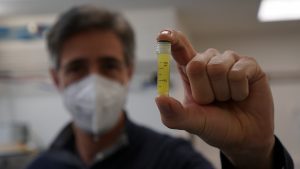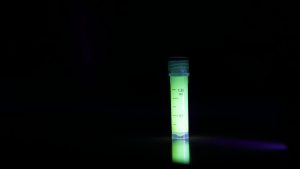
Researchers from the Universitat Politècnica de València (UPV) have developed a luminescent hydroalcoholic gel aimed at monitoring the quality of disinfection following handwashing.
There are nine million cases of healthcare-associated infections (HAIs) every year in Europe, causing millions of additional days in hospital and huge economic impacts on healthcare systems. HAIs can be prevented with the correct handwashing procedures, yet an estimated 89% of the population leaves some parts of their hands unsterilised.
There is no solution for the immediate, safe, economic, and routine monitoring of the handwashing process when using hand sanitisers.
Researchers at the Nanophotonics Technology Center at UPV have developed a luminescent hydroalcoholic gel to aid hand disinfection, allowing the immediate, safe and routinary visual discrimination of correctly/incorrectly disinfected areas using a simple UV lamp.
The importance of handwashing
Hands are one of the most important links within the infective chain. There are a plethora of studies demonstrating that the hands of patients and healthcare professionals are the main vector of infective disease transmission. Footwear and other surfaces in contact with hands and feet are also contributing to the dissemination of harmful pathogens.
HAIs pose a huge social and economic problem. In fact, the importance of handwashing was evidenced back in the 1840s by the Hungarian physicist, Ignaz Semmelweis to explain the spread of infective diseases. Semmelweis proposed a simple but effective solution: hand disinfection (using a chlorine solution).
Nowadays, appropriate sink-based hand disinfection requires water, antiseptic soap and an adequate technique for the handwashing and drying processes. However, this strategy faces some problems: occasionally, it can be difficult to count on the right infrastructures (water supply and drying systems). Even if the correct infrastructures are in place, it is difficult to stick to the recommended handwashing practice because of a lack of time (especially in hospitals). On the one hand, if healthcare providers adhere to the recommended 40-80 seconds hand-washing process (when they need to do it 20 times/hour), they would spend a third of their working day doing this, which is not efficient. Conversely, an average hand-washing time between 8 and 20 seconds is not enough for most of the disinfection agents to be completely effective. Therefore, the full compliance with sink-based handwashing guidelines is not realistic.
An alternative disinfectant able to overcome those problems was pursued in order to perform the hand-washing process anytime and anywhere. Ethanol proved to be a broad-spectrum antiseptic in 1875 by Leonid Bucholz, but employing a liquid disinfectant was a bit messy and annoying. Thus, hydroalcoholic gels were conceived as a mixture of alcohol and a thickening agent, able to provide a portable, efficient, and comfortable sanitising experience.
Hydroalcoholic gels have made a huge difference in hospital environments and were used widely in 2009 following the AH1N1 Influenza virus epidemic. Subsequent epidemics have contributed to its growing demand. The SARS-CoV-2 coronavirus pandemic made the global population more aware of just how important correct handwashing is and hydroalcoholic gels became an accessible and preventative measure to mitigate the spread of COVID-19 and other infective diseases. Indeed, this measure was adopted at entrances to hospitals, stores and public and private establishments.
Despite this, many studies have demonstrated poor handwashing techniques adopted by the vast majority of the population. In order to address this problem, an adequate handwashing technique was developed in 1997 and updated in 2013, regulating the validation and efficiency of disinfectant gels. This is the hand-rub procedure endorsed by the CDC and World Health Organization (WHO), which might be carried out within 20-30 seconds:
- Applying the hand sanitiser, filling the cupped hand, and covering all surfaces;
- Rubbing hands palm-to-palm in a circular motion;
- Cleaning the back of each hand with the palm of the opposite hand;
- Scrubbing between the fingers by interlacing them and rubbing back and forth;
- Cleaning the back of the fingers with the palm of the opposite hand;
- Scrubbing each thumb with the opposite hand;
- Rubbing the fingertips into the palm of the opposite hand; and
- Washing each wrist with the opposite hand.

89% of people, and even 79% of medical students, still leave several parts of their hands (usually thumbs and fingertips) unsterilised. The quality of the handwashing technique might be validated by the microbiologic analysis of the hand’s surface. Even if this test is quite precise, it suffers from a long time-to-response and does not distinguish disinfected from ‘un-disinfected’ areas, preventing their use to monitor the right handwashing of patients accessing the hospital. In fact, there is no solution for the immediate, safe, economic, and routine monitoring of the handwashing process when using hand sanitisers.

Monitoring hand hygiene
Healthcare providers monitor their handwashing technique with fluorescent rubs, able to identify the disinfected and unsterilised areas, improving their compliance with handwashing guidelines. However, this strategy is not valid for monitoring efficient handwashing for people accessing hospitals, because those rubs are only conceived for educational purposes as they are not biocides, and are not recommended on a daily basis by their providers.
With the aim of enhancing the entire population’s compliance with handwashing guidelines, the Nanophotonics Technology Center at Universitat Politècnica de València has developed a luminescent hydroalcoholic gel. This biocide not only provides adequate hand disinfection but also monitors the quality of the sanitising process in a safe, immediate, simple, economic and routinary manner, due to the presence of safe luminescent particles in its formulation. These advantages might be exploited at establishment’s entrance points where high volumes of people meet and congregate such as at hospitals, shopping centres or even public/private institutions, to guarantee the correct handwashing process of each person and therefore, to guarantee the safety of everyone. This is the main result of Project LEGO (LuminEscent hydroalcoholic Gel and photonic device to monitor the quality of any (hand-) sanitising process), which has received funding from Agencia Valenciana de la Innovación (AVI, Generalitat Valenciana).
Even inexperienced users might employ the luminescent hydroalcoholic gel to sanitise their hands and easily identify the disinfected and unsterilised areas in a visual and intuitive way with just a simple ultraviolet (UV) lamp. Besides, the luminescent gel is also compatible with more sophisticated photonic devices able to obtain and process the hands’ luminescence to provide relevant statistical information to aid further improvement in the handwashing procedure. Security personnel controlling the access of people to hospitals or any other places, could survey the efficacy of handwashing with a quick inspection under a UV lamp, and provide advice to users in order to improve their technique if required.
The fluorescence is triggered by illuminating the hands with near-visible UV-A light (395-415nm) for only a few seconds (5-10 seconds for both palms and back of hands). UV-A has been chosen instead of more energetic parts of the UV spectra (such as UV-C, currently used for objects disinfection) because it is the less energetic part of UV light, almost visible light, so it is more compatible with its application on the human skin. Furthermore, the luminescent gel is formulated to guarantee safety and maximise skin protection, it includes ingredients able to absorb UV light, prevent skin permeability and hand dryness, providing a moisturising, calming, smoothing and even anti-ageing effect.
Finally, this strategy might also be extended to the disinfection of other surfaces, such as footwear (which is not currently being controlled), floors and walls, especially in hospitals, food outlets etc. Subsequent research steps will address these possibilities, by developing different sanitising compositions purposedly designed for those applications.
In conclusion, the luminescent hydroalcoholic gel and derived solutions will contribute to breaking the infective chain in a safe, efficient, and global manner, preventing disease transmissivity, and significantly reducing HAIs, therefore improving European citizens’ quality of life, and reducing the HAI-associated financial burden for both society and national healthcare systems.
David Ortiz de Zárate Díaz
PhD in Chemistry/Nanomaterials
Nanosystems Area
Valencia Nanophotonics Technology Center
ntc.webs.upv.es
https://www.linkedin.com/in/david-ortiz-de-z%C3%A1rate-d%C3%ADaz-1bb32251/?originalSubdomain=es
This article is from issue 21 of Health Europa Quarterly. Click here to get your free subscription today.










